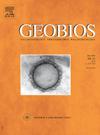Diversity of the pterodactyloid ichnites of Crayssac (Lower Tithonian, Late Jurassic, southwestern France)
IF 1.6
4区 地球科学
Q2 PALEONTOLOGY
引用次数: 0
Abstract
The ichnosite of Crayssac (Upper Jurassic, southwestern France) yields numerous vertebrates and invertebrates trackways, among which the pterodactyloid pterosaur trackways are frequent. One hundred and sixty nine vertebrate trackways (turtles, crocodilians, dinosaurs and pterosaurs) have been unearthed by our team. They are preserved in situ, are sheltered by a building and legally protected within the Réserve Naturelle Nationale Géologique du Lot. Among these vertebrate trackways, sixty-four can be attributed to tiny- to medium-sized pterodactyloids, representing five morphotypes referred to five new ichnospecies: Morphotype I, Pteraichnus occitanis (1 specimen); Morphotype II, Pteraichnus cadurcii (12 specimens); Morphotype III, Pteraichnus communis (21 specimens); Morphotype IV, Pteraichnus dichnopollex (10 specimens); and Morphotype V, Pteraichnus pyrenaicus (7 specimens). These trackways are finely preserved and represent a unique, abundant and diversified sample. Study of complete trackways rather than isolated footprints allows access to important parameters such as the velocity or the comparative gauges. Similarly, the orientation of all vertebrate trackways shows that the pterosaurs moved actively across the mudflat, without preferred direction.
克雷萨克(法国西南部晚侏罗世下梯东世)翼手类岩的多样性
Crayssac(法国西南部上侏罗统)的ichnosite上发现了许多脊椎动物和无脊椎动物的足迹,其中翼手类翼龙足迹较为常见。我们的团队已经发现了169条脊椎动物的足迹(海龟、鳄鱼、恐龙和翼龙)。它们被保存在原地,受到建筑的保护,并受到国家自然保护组织(r serve Naturelle Nationale g ologique du Lot)的法律保护。在这些脊椎动物足迹中,64条属于中小型翼手纲,代表5种形态类型,涉及5个新种:形态类型I, Pteraichnus occitanis(1个标本);形态型II型,无迹蝶(12份);3型,共翼毛虫(21份);形态型IV,双斑翼蚊(10份);V型为pyrenaichnus(7份)。这些铁轨保存完好,代表了一个独特、丰富和多样化的样本。研究完整的轨道,而不是孤立的足迹,可以获得重要的参数,如速度或比较仪表。同样,所有脊椎动物足迹的方向都表明翼龙在泥滩上主动移动,没有偏好的方向。
本文章由计算机程序翻译,如有差异,请以英文原文为准。
求助全文
约1分钟内获得全文
求助全文
来源期刊

Geobios
地学-古生物学
CiteScore
3.30
自引率
6.20%
发文量
28
审稿时长
6-12 weeks
期刊介绍:
Geobios publishes bimonthly in English original peer-reviewed articles of international interest in any area of paleontology, paleobiology, paleoecology, paleobiogeography, (bio)stratigraphy and biogeochemistry. All taxonomic groups are treated, including microfossils, invertebrates, plants, vertebrates and ichnofossils.
Geobios welcomes descriptive papers based on original material (e.g. large Systematic Paleontology works), as well as more analytically and/or methodologically oriented papers, provided they offer strong and significant biochronological/biostratigraphical, paleobiogeographical, paleobiological and/or phylogenetic new insights and perspectices. A high priority level is given to synchronic and/or diachronic studies based on multi- or inter-disciplinary approaches mixing various fields of Earth and Life Sciences. Works based on extant data are also considered, provided they offer significant insights into geological-time studies.
 求助内容:
求助内容: 应助结果提醒方式:
应助结果提醒方式:


